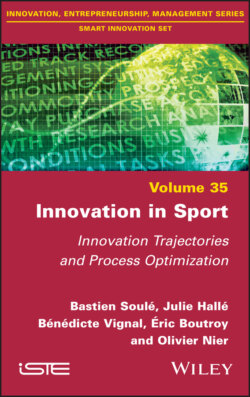Innovation in Sport

Реклама. ООО «ЛитРес», ИНН: 7719571260.
Оглавление
Bastien Soule. Innovation in Sport
Table of Contents
List of Illustrations
List of Table
Guide
Pages
Innovation in Sport. Innovation Trajectories and Process Optimization
Acknowledgements
Introduction. I.1. Desacralizing innovation
I.2. The importance of innovation in sports
I.3. What innovation is and is not: in search of a definition
1. Theoretical Elements: A Multidisciplinary Framework between Sociology and Management of Innovation
1.1. Classical approaches to innovation
1.2. Approaches based on uses and users
1.2.1. The lead-user theory: the user-innovator
1.2.2. Innovation through use: user participation
1.2.3. Co-creating value: the consumer at the heart of innovation
1.3. The socio-technical approach to innovation: networks and attachment
1.4. Critical innovation studies
1.5. Lessons learned from resistance to innovation and unsuccessful processes
1.6. Conclusion
2. The Different Phases of Innovation Trajectories. 2.1. Proposal for an interpretive framework
2.2. Breakdown of the methodology
2.3. Ideation and invention
2.3.1. Innovation program and strategic intent
2.3.2. Construction, characterization and evolution of the socio-technical innovation network
2.3.3. Key moments in innovation trajectories
2.4. Relations with users and the market
2.5. Success or failure: assessment of the innovation project and effects on the organizations
3. Detailed Accounts of Three Sports Innovation Trajectories
3.1. The dualski: making downhill skiing accessible to people with disabilities. 3.1.1. Technical description of the device
3.1.2. Ideation: at the intersection of several actors and projects
3.1.3. Innovation program: towards the empowerment of disabled people
3.1.4. Composition and dynamics of the innovation network surrounding wheelchair skiing
3.1.5. Relations with users and the market
3.1.6. Conclusion
3.2. The Booster Elite calf compression sleeve from BV Sport: innovating to promote recovery and prevent injuries. 3.2.1. Presentation of the product
3.2.2. Ideation phase
3.2.3. Innovation program and strategic intent
3.2.4. Construction, characterization and evolution of the socio-technical network. 3.2.4.1. High-level athletes and national federations
3.2.4.2. Yarns and knitting
3.2.4.3. Tests and scientific evidence
3.2.5. Key moments in the innovation trajectory
3.2.6. Compromises made by BV Sport: between science and market realities
3.2.7. Market and user relations
3.2.7.1. Competition
3.2.8. Conclusion
3.3. Hyperion 7: innovating in the field of video recording sports events
3.3.1. The invention phase: the collective emergence of an idea that is less original than adequately problematized
3.3.2. The creation of an innovation network focused on the issue of security
3.3.3. A network of territorialized actors with its own rules
3.3.4. A deliberately delayed step: starting a business
3.3.5. The business model envisaged
3.3.6. Early and unexpected prospects for diversification
3.3.7. A dizzying prospect
3.4. Appendices. 3.4.1. The company Booster Veines Sport (BV Sport)
3.4.2. Strategic intent
3.5. Sources used. 3.5.1. Tessier Dualski. 3.5.1.1. Interviews
3.5.1.2. French press articles
3.5.1.3. Webographies
3.5.2. BV Sport compression sleeve. 3.5.2.1. Interviews
3.5.2.2. Patents
Conclusion. Recommendations for the Management of Sports Organizations
C.1. Favoring realistic pictures over beautiful stories
C.2. Creating a good product does not guarantee success
C.3. The network as the real “hero” of innovation trajectories
C.4. Co-construction, flexibility and adaptability at the heart of success
References
Index. A
C
D
E, F
I
M,N
P, R, S
T, U, V
WILEY END USER LICENSE AGREEMENT
Отрывок из книги
Smart Innovation Set
coordinated by
.....
Fostering consumer-centric interactive approaches should not be idealized as it does not protect against a symmetrical phenomenon of value co-destruction through misuse (Plé and Chumpitaz Cáceres 2010), resistance (fan protests in sports shows, see (Stieler et al. 2014)), or loss of value for other stakeholders. Boutroy and Bodet (2017) showed, for example, how an innovation process based on a strong co-creative approach adopted by a sports goods manufacturer (relying on its fan community) failed to succeed owing to the co-destruction of value for ordinary consumers as much as for intermediaries. Focusing on the Nike Run Club mobile sports app, Charitsis et al. (2018) also show that the co-creator of value can be somewhat unknowingly co-creative, as the data harvested on their physical activity is subject to secondary use by the producers of these apps.
In this respect, it remains important to move beyond the company-consumer dyad to take into account all interacting stakeholders (Woratschek et al. 2014), relying in particular on the notion of stakeholder network, as Grohs et al. (2020)3 did in the case of sports events.
.....